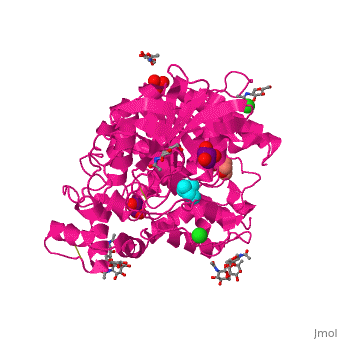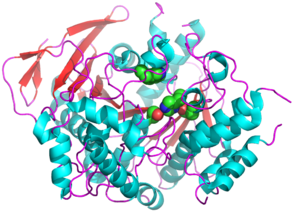Butyrylcholinesterase
From Proteopedia
(Difference between revisions)
| Line 2: | Line 2: | ||
[[Image:HuBChE.png|left|300px]] | [[Image:HuBChE.png|left|300px]] | ||
| + | == Function == | ||
| - | [[Butyrylcholinesterase]] (BChE) is an enzyme widely distributed throughout the body in humans, but particularly prevalent in serum, where it occurs as a tetramer of catalytic subunits. It is distinguished from the homologous enzyme, acetylcholinesterase, by its ability to hydrolyze the non-natural substrate butyrylcholine as well as the neurotransmitter, acetylcholine. | + | [[Butyrylcholinesterase]] (BChE) is an enzyme widely distributed throughout the body in humans, but particularly prevalent in serum, where it occurs as a tetramer of catalytic subunits. It is distinguished from the homologous enzyme, acetylcholinesterase, by its ability to hydrolyze the non-natural substrate butyrylcholine as well as the neurotransmitter, acetylcholine. |
| + | |||
| + | == Relevance == | ||
| + | |||
| + | BChE biological role remains obscure, but mutations in the human BCHE gene result in prolonged post-surgical apnea due to the inability of the mutant BChEs to hydrolyse the local anaesthetic, succinylcholine. BChE finds medical use as a bioscavenger for overcoming organophosphate (OP) nerve agent and insecticide intoxication by interacting rapidly with the toxic agents. | ||
</StructureSection> | </StructureSection> | ||
Revision as of 07:57, 15 November 2015
| |||||||||||
3D structures of BChE
Updated on 15-November-2015
Additional Resources
For additional information, see: Alzheimer's Disease
Proteopedia Page Contributors and Editors (what is this?)
Michal Harel, Alexander Berchansky, Lakshmi Venkatachalam, Joel L. Sussman, Jaime Prilusky, David Canner


